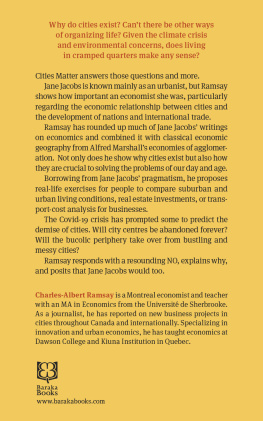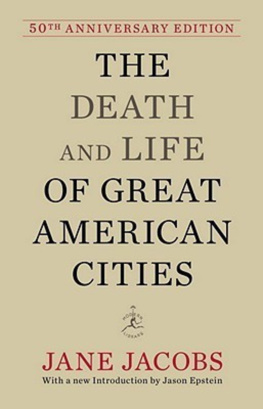People ask themselves why cities exist? Cant there be other ways of organizing life on earth? Given the climate crisis and environmental concerns, how can we justify building taller buildings, and living in cramped quarters?
This book will answer those questions. There are really good reasons why cities exist. There are also really good reasons to believe that cities can help us solve the problems of our day and age.
The books main value proposition is to corral much of the economic theory in Jane Jacobs writing, in a palatable and concise format. The book also explains classical economic geography theory, such as central location theory, and Alfred Marshalls economies of agglomeration. The book proposes real-life exercises for regular people who wish to compare suburban and urban living conditions, real estate investments, as well as transport-cost analysis in a business case.
I would like to thank the following colleagues and professors for their help in sharing their ideas and insights about cities and the economy. Dr. Petr Hanel, Dr. Richard Shearmur, Dr. Roma Dauphin, Dr. Jean-Philippe Meloche, James Roberts, Sacha Des Rosiers, and Dr. Worku Aberra.
Introduction
Why do cities exist? Ive been asking myself that question for a long time. I really like cities. I like walking through them, biking around in them, and hanging out in their restaurants. A lot of people take the fact of cities for granted, thats just the way things are, right?
Well, there IS a reason for cities. And the main reason is the economic reason. This is the whole point of this book. The economics of cities are driving all sorts of other phenomena.
If you look at it from other angles, you will find that cities have a lot of explaining to do! Politically, cities are a little problematic. They grow taller and wider and generate lots of tension between rural areas and urban ones. Socially, they have their pros and cons, the first mostly being the possibility of a cosmopolitan lifestyle, where you can eat exotic meals, see cutting-edge art, and meet people from all over the world. The latter being the insecurity, traffic, pollution, and general anguish that cities can generate. Historically, cities have not existed as long as humans. So technically we dont need cities to exist as a species on planet earth. Geographically, cities often grow in areas where resources are really scarce, or where there is barely even any land. Environmentally speaking, cities seem to encourage the over-consumption of resources and constantly create new types of pollution.
Given our recent past with pandemics and all, you might be wondering, are cities doomed? Are people going to work from home all the time and leave the downtown office towers? This question has been on many peoples minds, including landowners, real estate investors, regular families, and policy makers.
You might be asking yourself, should I buy a house in the city? In the suburbs? In a small town? Help!!!
My answer to all of this is NO, cities are not doomed.
Does that mean you should buy a house in the core? Thats not for me to say. Although I love strategizing other peoples lives, especially my friends lives, this book is not about advice. Dont call me and complain about how you bought a condo and hate it.
Back to our main point: this book is about the economics that explains the glue that binds people together in tight, awkward spaces. Hopefully, you will agree, cities still have a role to play in saving our human civilization. And also, hopefully, you will come to appreciate the epic wisdom of one smart lady: Jane Jacobs.
Jane Jacobs is an American author (she moved to Toronto in the late sixties) who is responsible for changing the way we think about cities, especially about urban planning. When you see cities all over the world tearing down highways, and rebuilding old-style walkable neighbourhoods, they are using the Jacobs playbook. If you hear economists lauding the innovation and diversity of metropolitan economies, they are applying and repeating the principles that Jacobs laid out in her books.
Her first book came out in 1959, The Death and Life of Great American Cities. It was a harsh criticism of New York Citys urban planning since the end of World War II. She had gained most of her insights from walking the citys neighborhoods, on assignment for The New York Times newspaper. She would notice that some neighborhoods seemed to be safer, and livelier, than others. She also noticed that this was not due to higher incomes, but rather to the physical infrastructure, the street layouts, the shape and density of housing, the availability of commercial rentals on the street levels, and the way automobiles were dominating, or not, the landscape. In many cases, the worst living conditions were found in the newer housing projects, which had cost taxpayers millions of dollars. Being married to an architect, she discussed these issues at home, but also at the newspaper, and with readers. A brilliant self-taught learner, she spent hours in libraries reading about classical urban planning, and the sociology of cities.
Jacobs then put much thought into the next logical aspect of city life, its economy. In her 1969 book The Economy of Cities, she reframed classical economic modelling around the geography of the city, rather than the political nation. By doing so, she re-imagined the trade cycles of cities, and how that leads to product innovation, business opportunity, and city growth.
Reading these principles of economic life, while I was a younger university student, changed my mind about economics. At the time, in the early aughts, her theories were not part of the curriculum, even if her books were decades old. I felt a little bit like a mouton noir, as an undergraduate in an economics department where most professors, and students, were more interested in monetary theory, public finance, labour markets, and advanced statistical analysis. I have to thank Dr. Petr Hanel, my masters thesis director at Universit de Sherbrooke, for accepting my proposal and allowing me to test one of Jacobs hypotheses using patent data. The data confirmed the Jacobs hypothesis that large cities are associated with product innovation, while outside areas focus on new cost-cutting processes.
Jacobs economic theory is more akin to an older tradition called political economy, while not necessarily being left-wing. Her work does not sit well with complex mathematical modelling. Many readers see parallels in Jacobs work with the Austrian school of economic thought, which shares her focus on productive investment, entrepreneurship, and a literal understanding of production methods. One detail I really like about Jacobs is that she insists on listing products that are produced in a certain economy, instead of using broad industrial categories. For me, this shows that she cares about the reality of productionan on-the-ground empirical preoccupation that feels more like fieldwork, than anonymous statistical analysis.




